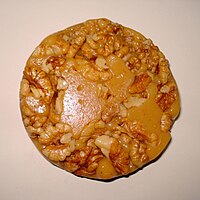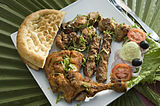Sohan halwa: Difference between revisions
>SharqHabib No edit summary |
CleanupBot (talk | contribs) m (→References: clean up, add source tag) |
||
| Line 69: | Line 69: | ||
{{India-cuisine-stub}} | {{India-cuisine-stub}} | ||
{{Pakistani dishes}} | {{Pakistani dishes}} | ||
{{en-Wikipedia}} | |||
Revision as of 03:30, 2 June 2021
 A variation of sohan halwa in the form of a circular disc | |
| Course | Dessert |
|---|---|
| Place of origin | West Asia and the Indian subcontinent |
| Main ingredients | cornflour, sugar, milk, water |
| Variations | Almonds |
| Other information | Halva |
Sohan halwa (Urdu سوہن حلوہ; [ˈsoːɦən ˈɦəlʋaː]) is a traditional dessert in South Asia, which is a variety of dense, sweet confection or halwa. Gheewala halwa is popular for sohan halwa since the Mughal era. There are hundreds of shops that produce sohan halwa in the cities of Multan (Punjab), Dera Ismail Khan (Khyber Pakhtunkhwa), and Old Delhi.
It is made by boiling a mixture of water, sugar, milk, and cornflour until it becomes solid. Saffron is used for flavoring. Ghee is used to prevent it from sticking to the pan. Almonds, pistachios, and cardamom seeds are added. Unlike most other halwa dishes in the Indian subcontinent, it is solid, similar to its Middle Eastern counterparts.
History

The origins of sohan halwa are believed to be in Persia. The word sohan is of Persian origin, and there is an almost identical brittle confection called sohan-e-qom in Iranian cuisine (Qom is a city in Iran)[1] Persian sohan is considered an ancient sweet, originally developed to be served during social gatherings.[2]
In Old Delhi, a 225-year-old Ghantewala sweet shop established during the reign of Mughal Emperor Shah Alam II, (r. 1759 - 1806) in 1790, made sohan halwa, and was a popular attraction,[3][4] but in 2015 it closed due to a lack of profitability.[5]
Commercial production
Sohan halway has been commercially produced by traditional confectioners for decades. It is brittle and caramelised, usually made into discs of 5-6mm thickness or as square bite-size pieces. It is usually packaged in intricately designed tin cylinders. In recent years other packages have also been common.[6]
Notable brands
- Hafiz Sohan Halwa
- Bhutta Sohan Halwa Multan
- Abdul Wadood Sohan Halwa Multan
- Rewari Sohan Halwa
See also
References
- ↑ Sohan-e-Qom: Persian Saffron Brittle Recipe. http://www.ahueats.com/2016/06/sohan-e-qom-persian-saffron-brittle.html . Accessed Feb 8,2021.
- ↑ [ht://www.hafizhalwa.com "- A Royal Sweet For Royal Palates"]. www.hafizhalwa.com.
- ↑ Planet, Lonely. "Restaurants in Delhi, India".
- ↑ The royal treat in Chandni Chowk The Hindu, Nov 07, 2002. Archived July 11, 2011, at the Wayback Machine
- ↑ "Ghantewala: Why did Delhi's 'oldest sweet shop' shut down?". 24 July 2015 – via www.bbc.com.
- ↑ Ramazani, Nesta (1997). Persian Cooking: A Table Of Exotic Delights. Ibex Publishers, Inc. p. 296. ISBN 978-0-936347-77-6.
- ↑ Usman, Nizam Ud Deen. "Multani Sohan Halwa". Multani Sohan Halwa.

